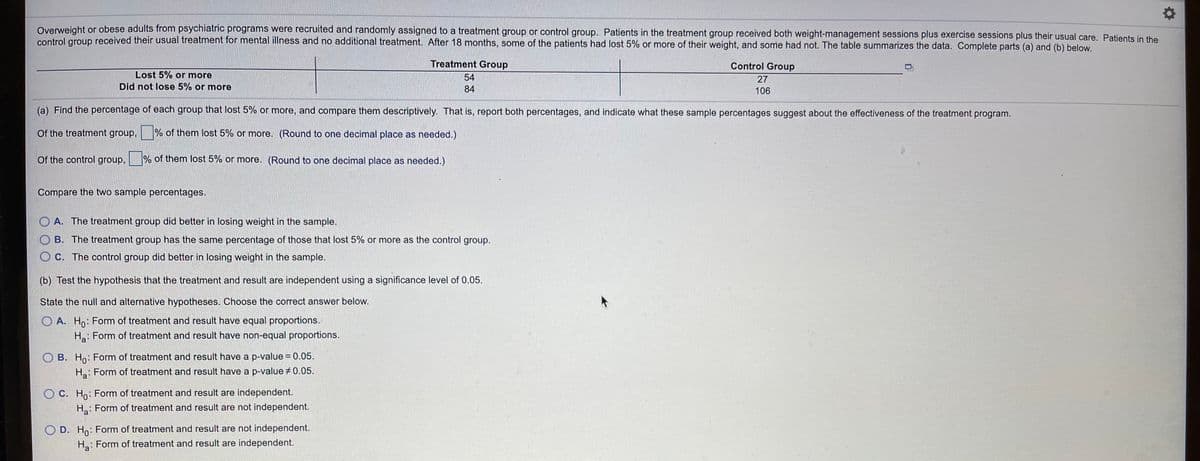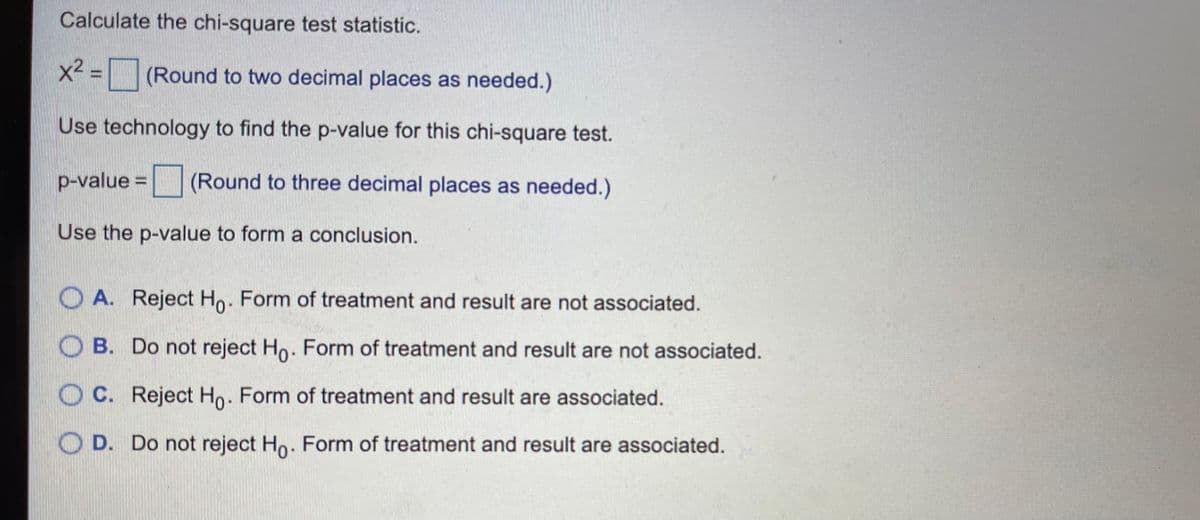Overweight or obese adults from psychiatric programs were recruited and randomly assigned to a treatment group control group received their usual treatment for mental illness and no additional treatment. After 18 months, some of the patients had lost 5% or more of their weight, and some had not. The table summarizes the data. Complete parts (a) and (b) below. control group. Patients in the treatment group received both weight-management sessions plus exercise sessions plus their usual care. Patients in the Treatment Group Control Group Lost 5% or more Did not lose 5% or more 54 27 84 106 (a) Find the percentage of each group that lost 5% or more, and compare them descriptively. That is, report both percentages, and indicate what these sample percentages suggest about the effectiveness of the treatment program. Of the treatment group, % of them lost 5% or more. (Round to one decimal place as needed.) Of the control group. % of them lost 5% or more. (Round to one decimal place as needed.) Compare the two sample percentages. O A. The treatment group did better in losing weight in the sample. O B. The treatment group has the same percentage of those that lost 5% or more as the control group. O C. The control group did better losing weight in the sample. (b) Test the hypothesis that the treatment and result are independent using a significance level of 0.05. State the null and alternative hypotheses. Choose the correct answer below. O A. Hg: Form of treatment and result have equal proportions. H Form of treatment and result have non-equal proportions. O B. Hn: Form of treatment and result have a p-value = 0.05. H: Form of treatment and result have a p-value #0.05. OC. H: Form of treatment and result are independent. H: Form of treatment and result are not independent. O D. Ho: Form of treatment and result are not independent. H: Form of treatment and result are independent.
Overweight or obese adults from psychiatric programs were recruited and randomly assigned to a treatment group control group received their usual treatment for mental illness and no additional treatment. After 18 months, some of the patients had lost 5% or more of their weight, and some had not. The table summarizes the data. Complete parts (a) and (b) below. control group. Patients in the treatment group received both weight-management sessions plus exercise sessions plus their usual care. Patients in the Treatment Group Control Group Lost 5% or more Did not lose 5% or more 54 27 84 106 (a) Find the percentage of each group that lost 5% or more, and compare them descriptively. That is, report both percentages, and indicate what these sample percentages suggest about the effectiveness of the treatment program. Of the treatment group, % of them lost 5% or more. (Round to one decimal place as needed.) Of the control group. % of them lost 5% or more. (Round to one decimal place as needed.) Compare the two sample percentages. O A. The treatment group did better in losing weight in the sample. O B. The treatment group has the same percentage of those that lost 5% or more as the control group. O C. The control group did better losing weight in the sample. (b) Test the hypothesis that the treatment and result are independent using a significance level of 0.05. State the null and alternative hypotheses. Choose the correct answer below. O A. Hg: Form of treatment and result have equal proportions. H Form of treatment and result have non-equal proportions. O B. Hn: Form of treatment and result have a p-value = 0.05. H: Form of treatment and result have a p-value #0.05. OC. H: Form of treatment and result are independent. H: Form of treatment and result are not independent. O D. Ho: Form of treatment and result are not independent. H: Form of treatment and result are independent.
Linear Algebra: A Modern Introduction
4th Edition
ISBN:9781285463247
Author:David Poole
Publisher:David Poole
Chapter7: Distance And Approximation
Section7.3: Least Squares Approximation
Problem 31EQ
Related questions
Topic Video
Question
Help please.

Transcribed Image Text:Overweight or obese adults from psychiatric programs were recruited and randomly assigned to a treatment group or control group. Patients in the treatment group received both weight-management sessions plus exercise sessions plus their usual care. Patients in the
control group received their usual treatment for mental illness and no additional treatment. After 18 months, some of the patients had lost 5% or more of their weight, and some had not. The table summarizes the data. Complete parts (a) and (b) below.
Treatment Group
Control Group
Lost 5% or more
54
27
Did not lose 5% or more
84
106
(a) Find the percentage of each group that lost 5% or more, and compare them descriptively. That is, report both percentages, and indicate what these sample percentages suggest about the effectiveness of the treatment program.
Of the treatment group,
% of them lost 5% or more. (Round to one decimal place as needed.)
Of the control group,
% of them lost 5% or more. (Round to one decimal place as needed.)
Compare the two sample percentages.
O A. The treatment group did better in losing weight in the sample.
O B. The treatment group has the same percentage of those that lost 5% or more as the control group.
O C. The control group did better in losing weight in the sample.
(b) Test the hypothesis that the treatment and result are independent using a significance level of 0.05.
State the null and alternative hypotheses. Choose the correct answer below.
O A. Ho: Form of treatment and result have equal proportions.
Ha: Form of treatment and result have non-equal proportions.
O B. Ho: Form of treatment and result have a p-value =0.05.
H: Form of treatment and result have a p-value +0.05.
O C. Ho: Form of treatment and result are independent.
H: Form of treatment and result are not independent.
D. Ho: Form of treatment and result are not independent.
H: Form of treatment and result are independent.

Transcribed Image Text:Calculate the chi-square test statistic.
x² =
x2:
(Round to two decimal places as needed.)
Use technology to find the p-value for this chi-square test.
p-value =
(Round to three decimal places as needed.)
Use the p-value to form a conclusion.
O A. Reject Ho. Form of treatment and result are not associated.
B. Do not reject Ho. Form of treatment and result are not associated.
C. Reject Ho. Form of treatment and result are associated.
D. Do not reject Ho. Form of treatment and result are associated.
O O0
Expert Solution
This question has been solved!
Explore an expertly crafted, step-by-step solution for a thorough understanding of key concepts.
This is a popular solution!
Trending now
This is a popular solution!
Step by step
Solved in 2 steps with 1 images

Knowledge Booster
Learn more about
Need a deep-dive on the concept behind this application? Look no further. Learn more about this topic, statistics and related others by exploring similar questions and additional content below.Recommended textbooks for you

Linear Algebra: A Modern Introduction
Algebra
ISBN:
9781285463247
Author:
David Poole
Publisher:
Cengage Learning

Functions and Change: A Modeling Approach to Coll…
Algebra
ISBN:
9781337111348
Author:
Bruce Crauder, Benny Evans, Alan Noell
Publisher:
Cengage Learning

Glencoe Algebra 1, Student Edition, 9780079039897…
Algebra
ISBN:
9780079039897
Author:
Carter
Publisher:
McGraw Hill

Linear Algebra: A Modern Introduction
Algebra
ISBN:
9781285463247
Author:
David Poole
Publisher:
Cengage Learning

Functions and Change: A Modeling Approach to Coll…
Algebra
ISBN:
9781337111348
Author:
Bruce Crauder, Benny Evans, Alan Noell
Publisher:
Cengage Learning

Glencoe Algebra 1, Student Edition, 9780079039897…
Algebra
ISBN:
9780079039897
Author:
Carter
Publisher:
McGraw Hill

Big Ideas Math A Bridge To Success Algebra 1: Stu…
Algebra
ISBN:
9781680331141
Author:
HOUGHTON MIFFLIN HARCOURT
Publisher:
Houghton Mifflin Harcourt